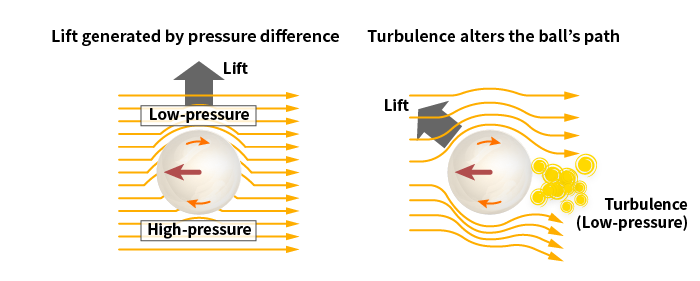Sports Tech@TDK
How do Breaking balls work? Why Do Breaking Balls Curve? Curves, Shoot, and Sliders...

There are various theories as to the origins of baseball but it is widely believed it originated from the game of ‘rounders’ which was brought to the U.S. in the 18th century and then developed into a national sport, with more detailed rules being established later in the 19th century. Rounders itself was derived from cricket, an old English aristocratic game. The first professional baseball league, Major League Baseball, was founded in 1903, and since 2006 the World Baseball Classic has been held every four years to determine the world's top national baseball team.
Aerodynamics Explain the Mechanism Behind Breaking Balls
It is said that 80% of baseball defense comes down to the pitchers. The average speed of a pitch in Major League Baseball is in the 90 mph (150 km/h) range, but speeds over 100 mph (180 km/h) have also been recorded. However, it is not always enough to have a high velocity. As the opponent's eyes become accustomed to the pitches, their timing becomes more precise, and if the pitch is hit just right, it will turn into a home run. That is why a fundamental part of pitching is the mixing of fastballs with breaking pitches in order to mislead the batter.
Pitchers throw many types of pitches, but they can be classified into straight pitches, vertical breaking pitches (falling pitches) such as fork balls and change-ups, and horizontal breaking pitches (curving pitches) such as the shoot and sliders. However, there are also types, such as curve balls that bend and fall sharply, or cut balls that look straight but change slightly once they reach the batter; though these are not explicitly classified.

By giving the ball a rotation, a variety of changes can be created. The way the ball changes also has to do with the stitching of the ball.

The ball is made of cork or rubber, wound with several thick layers of wool yarn, wrapped in two gourd-shaped skins, and then sewn together with thread. Not only are the size and weight of the ball strictly regulated, but the seams are also set to consist of exactly 108 stitches.
Ball stitches are also related to Breaking Balls
The rotation of the ball has a lot to do with what type of pitch a breaking ball results in. If the ball spins, the air flow will be dense on one side and low on the other side. This asymmetry in air flow results in a pressure difference that generates lift, which deflects the ball in the direction of travel according to Bernoulli's theorem. But that is not all that matters. Air turbulence behind the ball also plays a role in the change of direction.
Turbulence is a collection of small eddies of air, which have less pressure than their surroundings and act as a brake on the thrown ball. When rotation is applied, the turbulence behind the ball is displaced from the direction of the ball's travel, which can result in a curveball or a shoot. This effect that bends the path of the ball is called the Magnus effect. For pitchers, the aerodynamic drag present by the ball's design is not necessarily a nuisance, but rather utilized to make use of turbulence. Interestingly, the Magnus effect on the ball is greater when the speed of the ball is around 100 km/h than when it is 140 to 150 km/h. This is the reason the slow curve balls fall in such a large arc. Forkballs and knuckleballs, on the other hand, are pitches that are thrown as if they are being slipped out of hand, without imparting any spin on the ball. The speed is slow so the ball sways, with the turbulence acting as a brake, which then causes the ball to stall in the air and drop due to the gravity just as it reaches the batter.
The seams on the ball also subtly change the degree of turbulence generated, resulting in a wide variety of breaking balls and other pitches. For example, the term "two-seam" comes from the fact that the ball is thrown by placing one's fingers over two of the ball’s seams.
So now you know, breaking pitches are a complex combination of the amount of rotation on a ball, the direction and axis of the rotation, the orientation of the seams, and the velocity of the ball.

On one side of the spinning ball the air velocity is low, where the streamlines are dense, and on the other side the air velocity is high, where the streamlines are sparse. According to Bernouli’s theorem this difference in pressure results in a lifting force that accounts for the balls’ change in trajectory. The turbulence created at the rear of the ball plays a large role in altering the trajectory of the ball. With this spinning ball, the angle of turbulence is at an angle to the direction of travel. According to the Magnus effect the side with turbulence has less air pressure so force is generated that bends the trajectory.
How HDD Magnetic Heads Fly with Lift
HDD magnetic heads are also related to aerodynamics and lift. The read and write functions of a magnetic head are formed from the combination of many thin-film elements on a wafer using advanced thin-film process technology similar to that used in semiconductor manufacturing. These are cut and processed into chips that are 1 to 2 mm square, which are called sliders (Figure A). The magnetic head is made by attaching the slider to a head gimbal assembly (HGA).

The read/write coils are at the edge of the slider, which read and write while maintaining a very slight amount of levitation (flying) over the disk (platter), which rotates at high speed (Figure B).

As storage capacity improves, levitation gets narrower year by year, and is down to about 10nm (nanometers) or less in recent magnetic heads. To put this into perspective, that’s the equivalent of a jumbo jet flying at top speeds less than 1mm off the runway. This jumbo jet, which weighs several hundred tons, can fly because it gets lift from the air. One side of the slider is cut at an angle in order to allow for smooth air flow generated by disk rotation to reach the bottom of the slider.
In addition, grooves are carved on the bottom surface of the slider to enhance its aerodynamic characteristics, stabilize the amount of slider lift, and improve positioning accuracy (Figure C). The slider, which also serves as the wing of an aircraft, can thus fly just above the surface of the platter.

TDK’s Magnetic Head

TDK's magnetic head combines a high-sensitivity TMR element and a perpendicular magnetic recording PMR element that enables HDDs to have higher storage capacities and smaller form factors. It is used in PCs and HDD drives, as well as in magnetic heads for nearline storage HDDs, which is used in magnetic heads for near-line HDDs, the data center's mainstay storage, while incorporating new technologies to increase capacity.
TDK is a comprehensive electronic components manufacturer leading the world in magnetic technology






